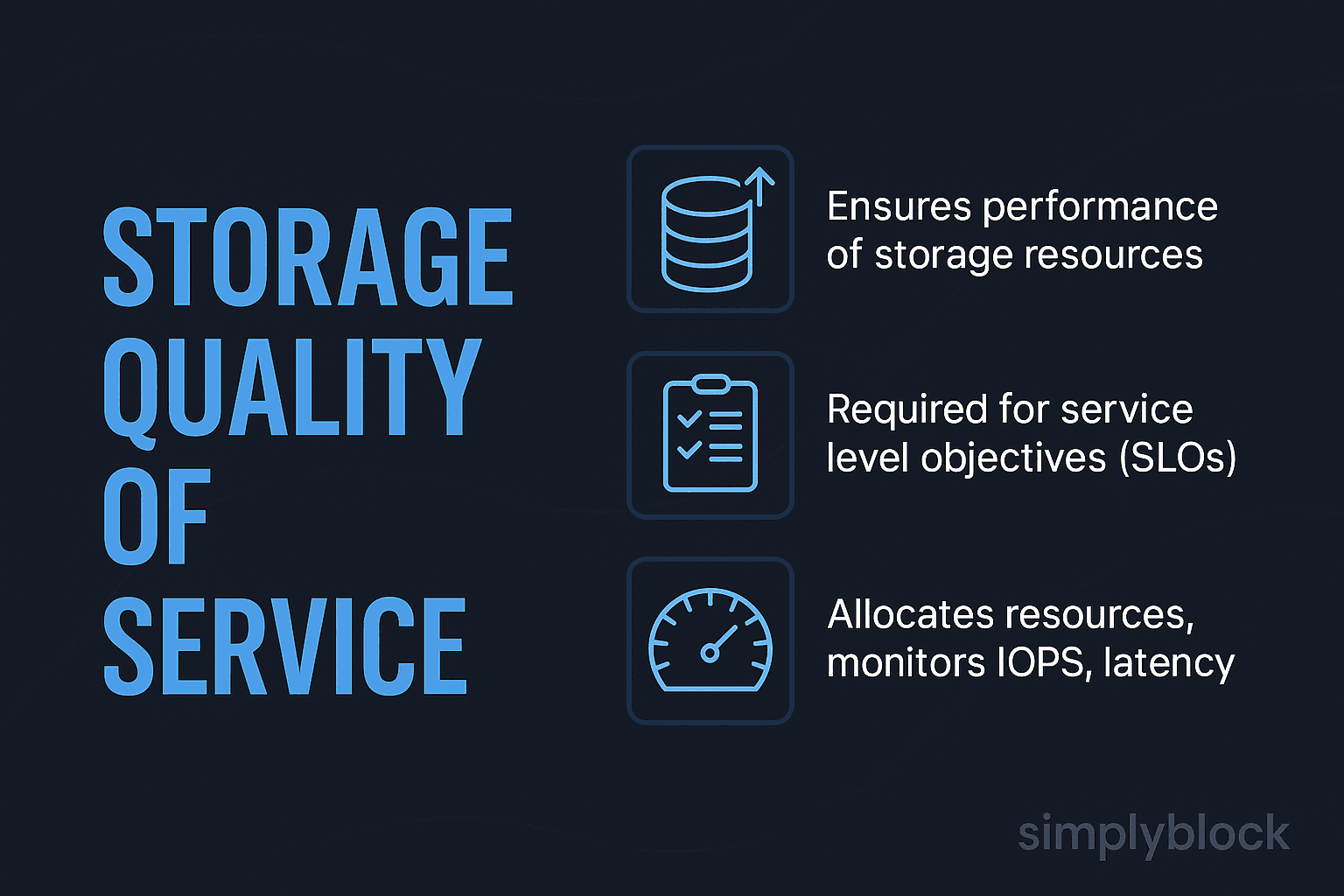Storage Quality of Service (QoS)
Terms related to simplyblock
Storage Quality of Service (QoS) is a mechanism used to control, isolate, and prioritize I/O performance across storage systems. It allows infrastructure operators to enforce throughput and latency guarantees, ensuring that one workload does not monopolize shared resources and degrade performance for others.
QoS is critical in multi-tenant, Kubernetes, and cloud-native environments, where different applications or customers demand guaranteed service levels. Platforms like simplyblock™ support fine-grained QoS controls to manage IOPS, bandwidth, and latency at the volume or tenant level.
How Storage QoS Works
Storage QoS policies are typically implemented through:
- Rate limiting: Restricts the maximum IOPS or bandwidth a volume or application can consume.
- Minimum guarantees: Ensures a baseline IOPS or throughput even under contention.
- Prioritization: Assigns relative importance to workloads using QoS classes or service levels.
- Isolation: Prevents noisy neighbors from affecting the performance of critical applications.
In Kubernetes environments, QoS can be defined at the PersistentVolumeClaim (PVC) level using annotations, or applied automatically via CSI-based storage platforms like simplyblock.
Benefits of Storage QoS
QoS provides multiple advantages across enterprise storage deployments:
- Performance stability: Ensures consistent response times for critical workloads even under load.
- Multi-tenant fairness: Prevents resource hogging in shared environments.
- SLAs & compliance: Enables enforcement of internal or contractual performance guarantees.
- Cost efficiency: Eliminates the need for overprovisioning by enforcing per-volume limits.
- Workload prioritization: Helps differentiate between dev/test and production tiers.
With multi-tenancy as a foundation, QoS enables platform teams to deliver reliable storage-as-a-service within Kubernetes and hybrid-cloud stacks.
Use Cases for Storage QoS
Storage QoS is essential in environments where performance isolation and predictable throughput are non-negotiable:
- DBaaS platforms: Isolate database workloads per customer while maintaining fair resource sharing.
- Kubernetes clusters: Guarantee IOPS for stateful workloads with PersistentVolumes.
- Cloud service providers: Offer tiered SLAs (e.g., gold, silver, bronze) with enforced limits.
- Mixed workload environments: Run analytics and OLTP workloads without interference.
- Disaster recovery pipelines: Throttle non-critical backup I/O to protect primary workload performance.

Storage QoS vs Resource Throttling vs SLOs
QoS goes beyond simple rate limits—it’s about managing performance expectations. Here’s how it differs from similar terms:
| Feature | Storage QoS | Throttling | Service Level Objectives (SLOs) |
|---|---|---|---|
| Scope | Per volume, workload, or tenant | Process or container level | Contractual or internal targets |
| Dynamic Adjustment | Yes | Sometimes | No (monitoring only) |
| Enforcement | Real-time | Static or reactive | Informational/alerting |
| Kubernetes Support | CSI, PVC annotations | Cgroup or resource requests | Tracked via observability tools |
| Ideal For | Multi-tenant storage platforms | App-level CPU/IO control | Compliance, reporting |
Storage QoS in Simplyblock™
Simplyblock provides advanced storage QoS controls natively at the software-defined layer. Capabilities include:
- Per-volume IOPS and throughput policies
- Priority-based scheduling across tenants or namespaces
- Integration with Kubernetes storage provisioning via CSI
- Real-time performance enforcement even during node failure or scaling
- Coexistence with multi-tenancy and snapshotting
This architecture supports true storage-as-a-service models while maintaining performance predictability in complex, multi-workload clusters.
External Resources
- Quality of Service in Kubernetes – Official Docs
- Storage Performance Isolation – TechTarget
- What is IOPS and How to Manage It – AWS
- Multi-Tenant Storage Challenges – Red Hat
- Managing Storage Performance – Microsoft Learn
Questions and Answers
Storage QoS ensures predictable performance by managing IOPS and throughput per workload or tenant. In shared infrastructures, QoS prevents noisy neighbors from degrading application performance, making it essential for multi-tenant storage and Kubernetes clusters.
In Kubernetes, Storage QoS can be applied via storage classes and CSI parameters. With a Kubernetes-native NVMe backend, platforms like Simplyblock can enforce per-volume QoS, ensuring fair resource distribution across workloads.
IOPS measures the number of read/write operations per second, while throughput measures the amount of data transferred. Storage QoS policies often cap or guarantee both, enabling consistent performance for latency-sensitive apps like databases.
Yes. By controlling performance tiers, QoS allows organizations to match workloads with the right level of resources. Combined with storage tiering, it prevents overprovisioning and reduces cloud costs.
It can, especially in systems where snapshots or backups compete for I/O. A QoS-aware storage backend ensures backup operations don’t throttle critical applications, especially when leveraging NVMe over TCP for fast, consistent performance.
